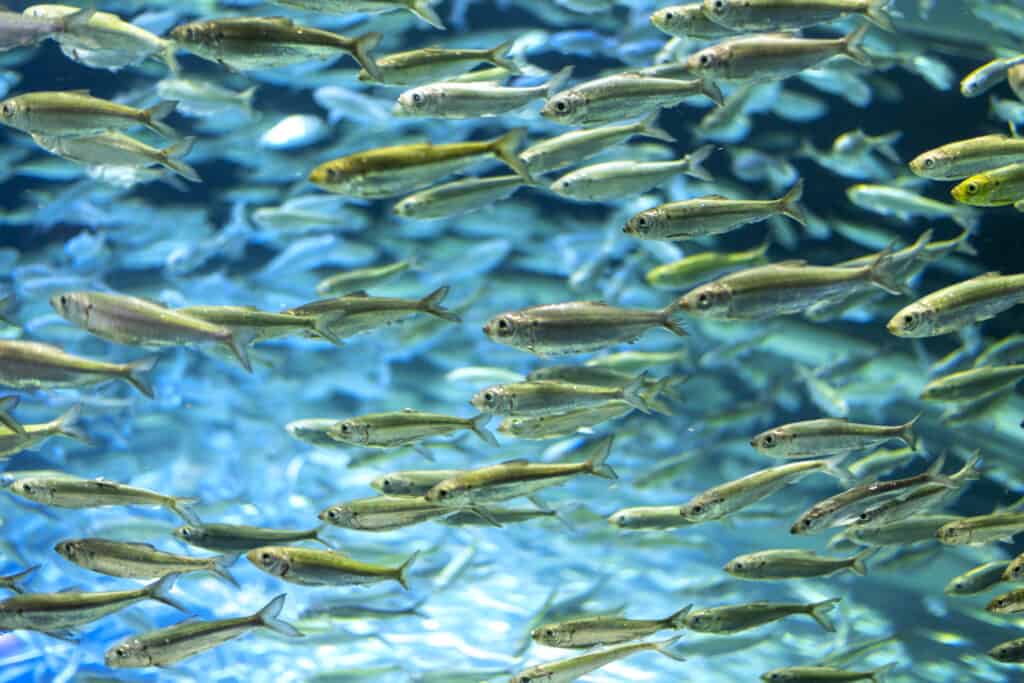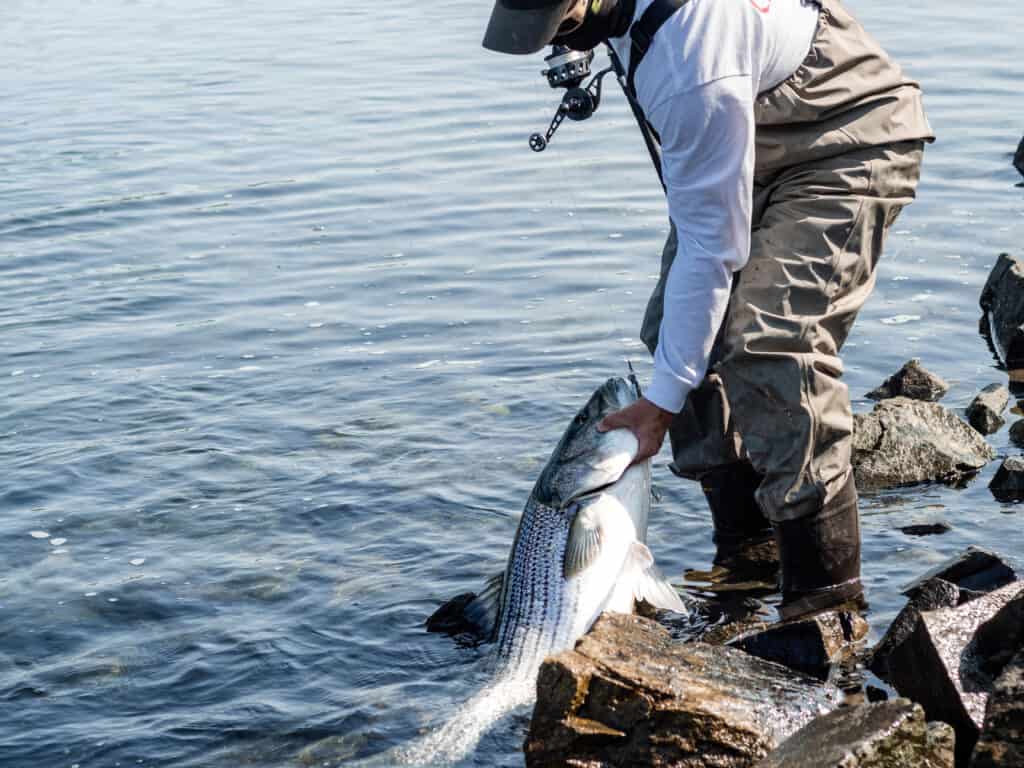Striped bass, or stripers, as many anglers call them, are an anadromous fish that can be found in either freshwater and saltwater depending on the season. Their migration patterns and lifestyles allow them to come in contact with a variety of organisms and potential meals. So, what do striped bass eat?
Let’s take a closer look at this sporting fish to learn more about the foods they eat. That way, you’ll know what bait to use the next time you hit your favorite fishing hole!

Striped bass are a sporting fish.
©slowmotiongli/Shutterstock.com
What Foods Do Striped Bass Consume?
Striped bass eat fish, insects, crustaceans, invertebrates, mollusks, zooplankton, and even some human foods. These bass are known to be partial toward eating smaller fish, which makes sense, as striped bass are primarily carnivores, actively seeking out smaller aquatic animals to satisfy their hunger.
Anglers often use some form of live bait to attract striped bass. Alewives, herring, shad, and smelt are all widely used when angling for striped bass. However, stripers can also be fooled into eating other types of meat like beef and pork. It goes without saying that such foods must be introduced to them by humans, but, interestingly, they’re willing to eat a wide variety of different meats.

Striped bass feed on smaller fish, like these alewives.
©iStock.com/Victor Korchenko
A Complete List of What Striped Bass Eats
Stripers are often seen eating a variety of foods, and some of their diverse diet depends greatly on their location. As mentioned before, striped bass are anadromous fish, primarily living in bodies of fresh water, though migrating to brackish or saltwater environments to spawn in the springtime. That means striped bass get access to many different kinds of fish, mollusks, and invertebrates throughout their lives. Nevertheless, adult striped bass are primarily piscivores.
That’s why a more thorough look at the foods striped bass eat includes:
- Alewives
- Anchovies
- Clams
- Cod (specifically, tomcod)
- Crab
- Eels
- Fish eggs
- Fish fry of many species
- Flounder
- Lamprey
- Lobsters
- Mackerel
- Menhaden (bunker fish)
- Mussels
- Sand dollars
- Sand Lance
- Sea herring
- Sea worms
- Sea urchins
- Shrimp
- Silver Hake
- Slim Jims (human food used as bait)
- Snails
- Squid
- Water fleas
- Zooplankton
Striped bass are not picky eaters. In fact, they are known to be ravenous consumers of just about anything smaller than they are.
However, they are not likely to consume fish with hard fins, instead sticking to those that are softer and easier to eat and digest.
Of course, some striped bass are landlocked, so they do not have the opportunity to eat saltwater fish. They do not, however, go hungry, as there is more than enough freshwater fare to keep their fishy bellies filled.
How Do Striped Bass Find Food?
Striped bass are opportunist. They tend to find their food by sight, smell, and by feeling changes in the water around them through vibrations. Stripers are known to actively hunt bottom dweller. Clams, mussels, and snails are typical fare for striped bass when they want an easy meal.
How Do Striped Bass Consume Food?
For the most part, striped bass consume their food whole. Stripers have rows of small teeth that face the back of their mouths. That way, they can bite and hold their prey for a moment before consuming the rest of the animal.
Are Striped Bass Dangerous to People?
Although striped bass have teeth, they are not dangerous to people. A striper is not going to attack you in the water. They are also not going to severely bite you if you’re careful while fishing for them.
However, you should be careful when you’re handling any large fish that you pull from the water. If they’re flopping around while you’re trying to remove a hook, it can lead to minor injuries. This is especially true of larger striped bass.
That’s why you should consider wearing gloves if you’re removing a hook from the animal. Minor irritations can result from lack of care around stripers’ small teeth.
What Do Baby Striped Bass Eat?
Striped bass are known for having a massive appetite starting when they can first feed themselves. When they are young, these fish mostly feed on insects, fish larvae, and tiny crustaceans. Once they are adults, they take on a more piscivorous diet. That’s when they start eating soft ray fish and many of other creatures.
What Do Striped Bass Eat in Winter?
Striped bass tend to move into deeper water in the winter. Their metabolism slows since fewer meals are available at that time of the year.
For the most part, stripers will continue to eat the same diet that they have throughout the rest of the year. The only difference is that the stripers won’t eat as much of the food as they do in warmer months.
What Eats Striped Bass?
Although striped bass can grow to be quite large, they are on the menu for other predators. Young striped bass need to look out for silver hake, cod, weakfish, and bluefish, though older, larger striped bass aren’t as enticing because of their size. Striped bass can reach lengths of 5 feet and weigh over 70 pounds, so they are more likely to be predator than prey. However, in open water even the largest striped bass can be prey to seals and sharks!

Striped bass can reach lengths of 5 feet and weigh over 70 pounds.
©Tfreeman_Films/Shutterstock.com
All in all, striped bass are some of the least discriminating fish when it comes to diet. They will consume fish, insects, crustaceans, mollusks, and even beef and pork who introduced by humans. As long as they can fit it into their mouths, they’ll make an attempt to consume it! That works out for anglers because they can get away with using many sorts of bait to lure these creatures to their hooks.
Up Next:
- The 7 Best Bass Fishing Lakes in Florida
- What Do Bass Eat?
- What Do Smallmouth Bass Eat?
- Discover the Largest Bass Ever Caught
- Discover The Largest Striped Bass Ever Caught in Florida
The photo featured at the top of this post is © slowmotiongli/Shutterstock.com
Sources
- mass.gov, Available here: https://www.mass.gov/service-details/learn-about-striped-bass#:~:text=Striped%20bass%20eat%20a%20variety,%2C%20sea%20worms%2C%20and%20squid.
- springer.com, Available here: https://link.springer.com/article/10.2307/1350872
- noaa.gov, Available here: https://www.fisheries.noaa.gov/species/atlantic-striped-bass#:~:text=Bluefish%2C%20weakfish%2C%20cod%2C%20and,exception%20of%20seals%20and%20sharks.
Thank you for reading! Have some feedback for us? Contact the AZ Animals editorial team.






